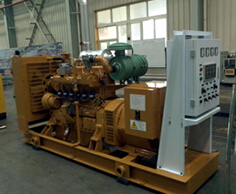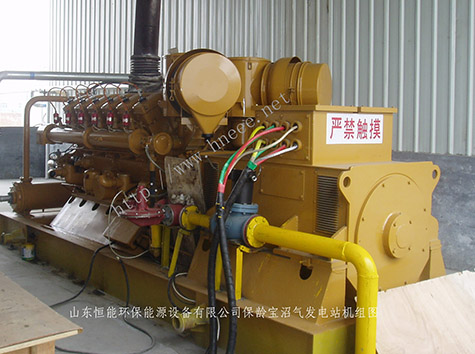如何才能分析瓦斯发电机组的噪音的区别?
根据瓦斯机组的工作原理,其噪声的产生非常复杂,从产生的原因和部位上来分:排气噪声、机械噪声、燃烧噪声、冷却风扇和排风噪声、进风噪声、发电机噪声。

According to the working principle of gas unit, the generation of noise is very complex. From the causes and parts, it can be divided into exhaust noise, mechanical noise, combustion noise, cooling fan and exhaust noise, air intake noise and generator noise.
一.排气噪声
1、 Exhaust noise
排气噪声是一种高温、高速的脉动性气流噪声,是发动机噪声中能量大,成分多的部分。比进气噪声及机体辐射的机械噪声要高得多,是发动机总噪声中主要的组成部分。它的基频是发动机的发火频率。排气噪声的主要成分有以下几种:周期性的排烟引起的低频脉动噪声、排烟管道内的气柱共振噪声、汽缸的亥姆霍兹共振噪声、高速气流通过气门间隙及曲折的管道时所产生的噪声、涡流噪声以及排烟系统在管道内压力波激励下所产生的再生噪声等,随气流速度增加,噪声频率显著提高。
Exhaust noise is a kind of high-temperature, high-speed pulsating airflow noise, which is a part of engine noise with high energy and many components. It is much higher than the intake noise and the mechanical noise radiated by the engine body, and it is the main part of the total engine noise. Its fundamental frequency is the firing frequency of the engine. The main components of exhaust noise are as follows: low frequency pulsating noise caused by periodic exhaust, gas column resonance noise in exhaust pipe, Helmholtz resonance noise of cylinder, noise produced when high-speed air flows through valve clearance and tortuous pipe, vortex noise and regenerative noise produced by exhaust system under pressure wave excitation in pipe, etc In addition, the noise frequency increases significantly.

二.机械噪声
2、 Mechanical noise
机械噪声主要是发动机各运动部件在运转过程中受气体压力和运动惯性力的周期变化所引起的震动或相互冲击而产生的,其中严重的有以下几种:活塞曲柄连杆机构的噪声、配气机构的噪声、传动齿轮的噪声、不平衡惯性力引起的机械震动及噪声。柴油发电机组强烈的机械震动可通过地基远距离传播到室外各处,然后再通过地面的辐射形成噪声。这种结构噪声传播远、衰减少,一旦形成很难隔绝。
The mechanical noise is mainly caused by the vibration or mutual impact of the moving parts of the engine caused by the periodic changes of the gas pressure and the motion inertia force in the process of operation. The serious ones are as follows: the noise of the piston crank connecting rod mechanism, the noise of the valve distribution mechanism, the noise of the transmission gear, the mechanical vibration and noise caused by the unbalanced inertia force. The strong mechanical vibration of diesel generator set can be transmitted to all parts of the outdoor through the foundation, and then form noise through the ground radiation. This kind of structure has the advantages of long-distance noise propagation and low attenuation, so it is difficult to isolate once it is formed.
三.燃烧噪声
3、 Combustion noise
燃烧噪声是柴油在燃烧过程中产生的结构震动和噪声。在汽缸内燃烧噪声声压级是很高的,但是,发动机结构中大多数零件的钢性较高,其自振频率多处于中高频区域,由于对声波传播频率响应不匹配,因为在低频段很高的汽缸压力级峰值不能顺利地传出,而中高频段的汽缸压力级则相对易于传出。
Combustion noise is the structural vibration and noise produced in the process of diesel combustion. The sound pressure level of combustion noise in the cylinder is very high. However, most parts of the engine structure have high rigidity, and their natural frequencies are mostly in the middle and high frequency region. Due to the mismatching of the response to the sound wave propagation frequency, the peak value of high cylinder pressure level in the low frequency band can not be smoothly transmitted, while the cylinder pressure level in the middle and high frequency band is relatively easy to transmit.
四、冷却风扇和排风噪声
4、 Cooling fan and exhaust noise
机组风扇噪声是由涡流噪声和旋转噪声组成的,旋转噪声由风扇的叶片切割空气流产生周期性扰动而引起;涡流噪声是气流在旋转的叶片截面上分离时产生的,由于气体的粘性引起的旋涡流,辐射一种非稳定的的流动噪声。排风噪声、气流噪声、风扇噪声、机械噪声均是通过排风的通道辐射出去的。
The fan noise of the unit is composed of vortex noise and rotating noise, which is caused by the periodic disturbance of the air flow cut by the blades of the fan; the vortex noise is caused by the separation of the air flow on the rotating blade section, which is caused by the viscosity of the gas and radiates an unstable flow noise. Exhaust noise, airflow noise, fan noise and mechanical noise are radiated out through the exhaust channel.
 在线咨询
在线咨询 官方二维码
官方二维码




 当前位置:
当前位置: 2021.04.10
2021.04.10






